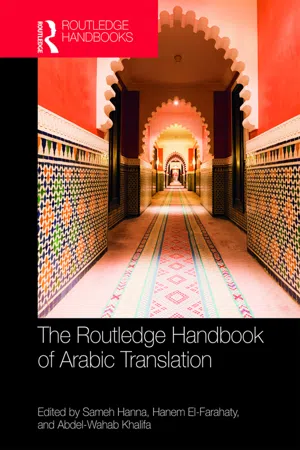![]()
Part I
Translating the sacred
![]()
Since the end of its revelation (632 ce), the preservation of the Qur’an quickly gave rise to important concerns as the influence of Islam grew outside of Arabia. While Muslims were already well established by the time of the caliphate of ‘Uthmān (577–656) in Syria, Egypt, Iraq, Iran, and at the borders of Azerbaijan, divergent manners of reciting the Qur’an had already started appearing. According to Hudhayfah ibn al-Yamān,1 new Muslims were reciting it in a manner that was altering its meanings. In response to the solicitation of his companions, the caliph decided to reproduce the Qur’an, which had been compiled and preserved by his predecessors, by making multiple copies available, in order to provide an official reference to be distributed in all the major centers of the Islamic state, still in expansion (von Denffer, 1994: 61–62).
Even though the preservation of the rigorous pronunciation of the Qur’an based on the Meccan dialect was guaranteed through its written reproduction, the contact of the Arabic language – for which the Qur’an became the archetype – with other cultures constituted an even greater challenge. How was the Qur’an, which had been revealed in a “clear Arabic language” (Qur’an, 16:103), whose very name means “expression,”2 going to withstand transformation as a result of its contact with other languages? Can the sacred text of Islam, whose claimed universality seems contradicted by its linguistic specificity, be translated?
In this chapter, it is proposed to deal with the question of the translation of the Qur’an from two different, yet complementary, angles. The first consists in presenting this question from an historical point of view, from the dawn of Islam until the contemporary era. In this non-exhaustive overview, the aim is to reveal the sociopolitical motives behind the translation of the Qur’an throughout history, as well as the disagreements between its proponents and detractors. This will be accompanied, as relevant, by summarized assessments of some of the representative translations of the Qur’an, based on textual comparison and an analysis of their introductions and prefaces. The second angle will attempt to elaborate on the analysis of the debate and to look at it from a translation studies perspective. In what way does Qur’anic translation offer a particular perspective on the representation of translation in the field of sacred texts? What are the issues at play in translation according to Muslim jurists? And ultimately, how is translation understood between the initial linguistic conservatism of Arab Muslims and the universality of Islam?
A brief history of Qur’anic translation
Qur’anic translation is not a new topic of discussion; in fact, it goes all the way back to the time of its revelation. In order to propagate its universal message, Prophet Muhammad (570–632 ce) sent messengers and letters to the kings, leaders and chiefs of other peoples. When messengers were used, they were well acquainted with the language of their recipient, and it was up to them to interpret the content of the letters, which were often punctuated with Qur’anic verses. Islamic history tells us that some of the companions of the Prophet translated parts of the Qur’an in his lifetime. For instance, Salmān al-Fārisī, born in Persia, would have translated the first chapter of the Qur’an in Persian, while Jaʻfar ibn Abī Tālib would have translated into Ge’ez, Abyssinia’s language, the verses related to the story of Jesus and Mary to the Negus of Ethiopia, when he was sent as ambassador at the beginning of the prophetic mission (Al-Maraghi, 1936: 24).
However, the internal debate concerning the translation of the Qur’an became much more serious after the passing away of the Prophet, when large numbers of people unable to speak Arabic embraced Islam. At the time of the death of Muhammad, Islam had spread almost everywhere in the Arabian Peninsula and to some parts of Iraq. Between 632 ce and 660 ce, Islam established itself as the religion all the way to the borders of Persia on the East, all across Turkey to the North, and had reached Libya to the West. Over the next 70 years, this expansion continued, covering Afghanistan, Pakistan, Turkey, parts of Russia, all of North Africa as well as Spain. The expeditious pace of this expansion and its geographical reach were necessarily going to favour the translation of the Qur’an in order to make its meanings accessible to all non-Arab Muslims.
Early and partial translations
The first translations of the Qur’an were therefore made into the languages of the new Muslims, but this did not happen without some resistance. For a Muslim, the Qur’anic language is one of the most miraculous aspects of the book. What fueled the debate around the translation of the Qur’an was, on the one hand, a motivation to translate it to make it accessible, while on the other hand, a resistance stemming from a strict religious position. The questions of whether it is linguistically possible and religiously permissible to translate the Qur’an had practical ramifications for Muslims: can prayers be observed using a translation? These are some of the questions with which jurists, exegetes and theologians had to contend. More conservative thinkers expressed a categorical disapproval of Qur’an translation; at the opposite end, some jurists not only allowed Qur’anic translation in general, but also the recitation of the translation during prayer, as we shall see. Between these two extremes th...
